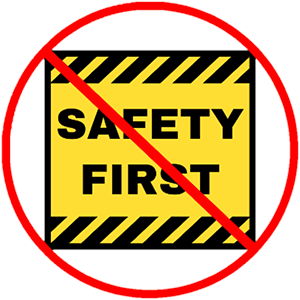
It makes me cringe when someone says, “Safety First.” Even more cringeworthy are “Safety First” slogans, banners, and stickers. The reason I cringe is simple – it isn’t true. No company ever puts safety first, EVER! Before you fire off a nasty email telling me how crazy I am, let me explain! I believe that most companies want to provide a safe workplace. I also believe that leaders will do what they think will work to provide a safe workplace. I believe leaders have good intentions and see “Safety First” slogans as an effective way to communicate the organization’s commitment to safety externally and reinforce that commitment internally among its workforce.
The problem remains – it isn’t true. Companies exist to provide goods or services, even non-profit companies. Companies do not exist to be “safe”, for if they did it would not be long before you would see another sign: “Closed for Business”!
It is not that I think companies are not safety-minded, it is just a reality of our work. Getting work done requires a balance between being safe and being productive while also maintaining quality, productivity, efficiency, etc. Todd Conklin said it best in his book, Pre-Accident Investigations: “People are as safe as they need to be, without being too safe, to get work done.”
I agree with Todd in that no one can be 100% committed to safety, just as no one can be 100% committed to productivity. If one were committed to working as safely as possible, they would not get much work done. On the flip side, if one were committed to working as hard and as fast as possible, not only would safety suffer, but also quality, efficiency, costs, etc. Getting work done requires a balancing act, it is not a “this or that” scenario.
Another reason “Safety First” slogans and stickers do not work for me is because no one ever means to have an accident. Accidents are just that, accidents. People rarely (okay, maybe one in a million) ever injure themselves intentionally. People carry out their work in the safest way they know how, given their experience, knowledge, skills, and training. How an individual accomplishes a job is also subject to a multitude of external factors like organizational culture and local job conditions and factors. Thus, telling someone to have a “Safety First” mindset does not help them work safely, or tell them how to work safely.
Lastly, an organization does more harm than good if its “Safety First” slogans, banners, and stickers conflict with the reality of what the worker experiences daily in the workplace. People are smart. People understand the difference between what leaders say and what leaders expect. If an organization tells people “Safety First” and then fails to provide the right training, tools, and support, then the motivational power of any “Safety First” sticker is lost.
Moving Beyond “Safety First” Platitudes
An organization’s commitment to working safely should be self-evident. It should not need to be supported or reinforced with catchy banners and slogans. Getting work accomplished in the safest, most productive way possible should just be the standard for how work gets done. As Sidney Dekker stated in his Field Guide to Understanding Human Error, “a system isn’t automatically safe; people have to create safety through practice at all levels of the organization”.
Bottom line: Asking people to “be safe” is insufficient. Do not simply tell workers to be safe; make it an expectation that is reinforced daily through their experiences in the workplace. Leaders in organizations need to evaluate organizational structures and systems that support how risk is assessed, managed, and controlled, facilitate communication across the organization, and instill a continuous improvement mindset.
Organizations focused on optimizing safety and operational performance have engaged leaders across the entire organization who demonstrate their commitment to safety consistently through what they say, and more importantly, what they do! Strong and effective leadership is necessary for any organization wanting to build a workplace culture where safety is truly valued!
Questions to Consider:
What results are senior leaders accountable for?
How do senior leaders visibly demonstrate their commitment to safety?
What would someone see leaders saying and doing that would indicate an unwavering commitment to safety and health?
The Lesson Here
Hold leaders accountable for what they say, and more importantly, what they do. Holding leaders more accountable, in turn, holds workers accountable and produces greater transparency and openness, enhanced teamwork and trust, effective communication and dialogue, thorough execution and follow-through, and sharper clarity with a tighter focus on results. Only then will working safely just be how work gets done!
Throw away your “Safety First” stickers, roll up your sleeves, and do the hard work it takes to build a workplace where safety is truly valued!

